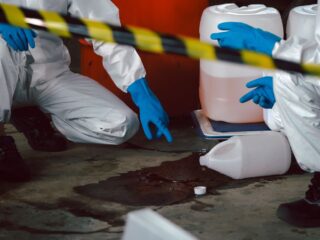
Do you feel anxious about upcoming stress tests? You are not alone! A stress test can be an intimidating experience but understanding the procedure can help reduce your worries.
In this blog, we’ll provide insights into what to expect during a stress test and how to best prepare for it. So, read on to know more.
Stress related eczema on hands
When undergoing a stress test, you may notice an increase in stress related eczema on your hands. Stress related eczema is caused by increased skin sensitivity when exposed to triggers like dust, cold temperatures, and other elements. In some cases, the skin irritation may be visible in the form of reddening and itchiness localized on your palms or the area of your fingers that come in contact with certain items.
Learn to recognize any signs of stress-related skin issues and inform your testing physician if you experience unusual symptoms during a stress test. Keeping your hands as dry as possible can help reduce any discomfort associated with existing cases of stress related eczema.
Foot stress fracture test
A foot stress fracture test is used to diagnose a stress fracture, which is a physical injury caused by repetitive force that puts strain on the bones. The test involves x-rays or other imaging techniques to detect any disruption of the bone’s structure. It is often done in combination with a biopsy and/or an MRI scan.
A stress fracture can come from overexerting yourself by running, jumping, or participating in other forms of exercise that put strain on the feet and bones. As an example, someone who runs long distances without taking regular breaks might be at risk for developing a stress fracture.
During a foot stress fracture test, your doctor will examine your feet for signs of redness, tenderness, swelling, or warmth which could indicate a possible injury. The doctor will then typically use radiography (x-rays), MRI scans, CT scans, or ultrasound studies to look for signs of disruption within the bone structure as well as microfractures that are not visible to the naked eye. Depending on the imaging technique used, follow-up tests may also be necessary for further analysis.
After diagnosing and analyzing any potential fractures or injuries present in your feet during the foot stress fracture test, your doctor will provide treatment options such as rest and physical therapy exercises along with recommendations to avoid further damage.

Signs you need a stress test
A stress test is an imaging study used to evaluate the effects of physical stress on your heart. Depending on the type of stress test, physical activity or intravenous medication (dye) may be used to stimulate your heart rate and create images of your heart muscle as you exercise. Stress tests can indicate if your heart is receiving adequate oxygenated blood during normal exertion, detect evidence of blockage in coronary arteries, and measure how well a damaged or weakened heart is functioning.
The most common warning signs and symptoms that you may need a cardiac stress test are chest pain and/or discomfort, shortness of breath, fatigue or feeling generally unwell while exercising. You may also experience irregular heart rhythms, anxiety or nausea during a stress test. If any of these symptoms occur during the test, let your physician know immediately so the team can assess whether another form of imaging may be necessary.

How long is a stress test
A stress test, also known as an exercise tolerance test or treadmill test, is a common medical procedure used to diagnose heart disease. During the test, you will be asked to walk on a treadmill or ride a stationary bike while connected to monitors that measure your heart rate and other vital signs. The amount of time you are on the treadmill or bike depends on your age and fitness level. Generally speaking, it takes between 10 and 30 minutes to complete the test.
The standard stress test typically starts with your resting heart rate and blood pressure being measured while you are lying down. Then you will be asked to walk (or in some cases run) at increasing speeds and/or inclines while your heart rate and other vital signs are monitored. Depending on the results of the initial resting portion of the test, these levels may be increased further during the course of the test. At various points during the testing process, technicians may ask you to stop exercising and take deep breaths or push certain buttons as part of their analysis. Afterward, your blood pressure and heart rate will be taken again as if returns to its resting state gradually over time.
Your doctor will review the results from your stress test along with other information from exams or imaging tests that could help diagnose any underlying medical issues. If any irregularities were noticed during exercise, medications may be prescribed for further protection against cardiac episodes such as angina or arrhythmias that can occur during physical exertion.

What not to do before a stress test
There are a few important things to be aware of before undergoing a stress test. Avoid eating or drinking any caffeinated products, such as coffee, tea, or energy drinks at least 3-4 hours prior to the examination. Caffeine can affect your heart rate and blood pressure, potentially altering the results of the test.
It is also important to avoid smoking for about an hour before the stress test. Nicotine increases your heart rate and can decrease circulation to your extremities, both of which could impede accurate readings during your test. Additionally, Vigorous exercise is not recommended just before a stress test as it can also interfere with accuracy of outcomes.
It is important to tell your doctor about any medications you may be taking and if you have an underlying medical condition that may affect results such as COPD or respiratory disorders. This will ensure your safety and the accuracy of results during testing.
Stress test cpt
A stress test CPT (short for code) is a test used to evaluate your heart health while you’re under physical stress. This can be done at your doctor’s office, a hospital or at a lab accredited by the College of American Pathologists (CAP). The procedure typically follows these general steps:
•The technician will ask you to lie down on an exam table and strap on sensors that will measure your ECG and other vital signs.
• You will then be asked to exercise or do an activity such as walking on a treadmill or riding a recumbent bike with increasing difficulty levels until your heart rate reaches 70-85% of its maximum.
• As the test progresses, the technician may take images of your heart, such as Echo cardiography or nuclear imaging depending on what was ordered by your physician.
•After the activity is complete and you have recovered to baseline measurements, the technician will release you with any instructions regarding additional testing or treatment needed.

Forehead stress acne
Forehead stress acne is a type of acne that appears during moments of high stress. It usually begins with a small group of red bumps or pimples, or as small whiteheads and blackheads in the affected area. Acne may have a number of underlying causes, including genetic and environmental factors such as hormones or diet. However, it’s often associated with psychological stress. The forehead is one of the most common places for acne to appear during stressful times due to the presence of larger oil-secreting sebaceous glands than other areas on your face.
When you are under prolonged stress, your body might release more hormones called androgens, which are responsible for stimulating oil production in the skin’s sebaceous glands. As a result, more sebum (oil) is produced than usual and can clog pores leading to breakouts on the forehead area. This type of acne may heal more quickly than other forms; however you should take preventive steps such as avoiding known triggers – such as sugar and fat -and using mild skincare products that aren’t overly harsh or abrasive on your skin.
Injection stress test
Injection stress tests are common cardiovascular stress tests used to diagnose and help assess the severity of coronary artery disease. A patient is injected with a radiopaque contrast agent, usually through an intravenous line, which allows the physician to visualize the size and shape of the heart chambers during a stress test. During this test, an electrocardiograph (ECG) machine tracks electrical activity in their heart while they exercise on a treadmill or stationary bicycle.
This type of stress test measures how well your cardiac muscle responds when increased demand is placed on it. If there are blockages in your coronary arteries, you may feel shortness of breath or chest pain as blood flow to certain areas of your heart is limited. This response can be seen on an ECG tracing and give physicians important information about your cardiovascular health that could otherwise go undiagnosed.












